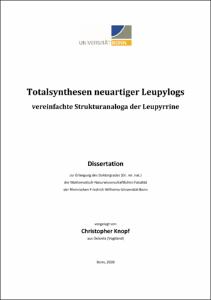Totalsynthesen neuartiger Leupylogsvereinfachte Strukturanaloga der Leupyrrine

Totalsynthesen neuartiger Leupylogs
vereinfachte Strukturanaloga der Leupyrrine

| dc.contributor.advisor | Menche, Dirk | |
| dc.contributor.author | Knopf, Christopher | |
| dc.date.accessioned | 2020-06-03T09:31:16Z | |
| dc.date.available | 2021-06-03T22:00:19Z | |
| dc.date.issued | 03.06.2020 | |
| dc.identifier.uri | https://hdl.handle.net/20.500.11811/8396 | |
| dc.description.abstract | Die vorliegende Dissertation behandelt die totalsynthetische Darstellung von neuartigen Strukturanaloga der Leupyrrine. Diese Stoffklasse myxobakterieller Sekundärmetabolite zeichnet sich durch die Kombination einzigartiger Strukturelemente aus. Der 18-gliedrige unsymmetrische Makrocyclus dieser Makrodiolide setzt sich aus einer Pyrrol-, Oxazolin- und einer ungewöhnlich substituierten ?-Butyrolactoneinheit zusammen. Die außergewöhnliche Struktur, vereint mit den hochpotenten antimykotischen und antiproliferativen Eigenschaften, machen die Leupyrrine zu einem überaus interessanten synthetischen Target. Die Zerlegung der Leupylogs in die vier Bausteine 73 , 99 , 113 und 164 bzw. 165 ermöglicht eine modulare Synthesestrategie. Als Schlüsselschritte sind eine sp2-sp3-Suzuki Miyaura -Kreuzkupplung zum Aufbau der Westfragmente 240 bzw. 241, eine HATU-vermittelte Amidbildung oder spurenlose Staudinger-Ligation zur Verknüpfung der West- und Ostfragmente, eine DAST-vermittelte Cyclodehydratisierung zur Oxazolinsynthese sowie eine Shiina Makrolactonisierung zu nennen. Über eine jeweils längste lineare Sequenz von 17 Stufen konnte Furan-Leupylog 280 mit einer Gesamtausbeute von 4.0% und Thiophen Leupylog 281 mit einer Gesamtausbeute von 3.3% erhalten werden. In Kooperation mit dem Arbeitskreis von Prof. Dr. Mark Brönstrup am Helmholtz-Zentrum für Infektionsforschung (HZI) wurde der Einfluss der strukturellen Modifikationen auf die biologische Aktivität untersucht, der Aufschluss darüber geben konnte, dass die Pyrrol-Oxazolin-Einheit der natürlichen Leuyprrine ein wichtiges Strukturelement des Pharmakophors dieser Naturstoffklasse zu sein scheint. | en |
| dc.description.abstract | Total Synthesis of novel Leupylogs – simplified Structural Analogues of Leupyrrins
This submitted thesis deals with the development of the total synthesis of novel Leupylogs, structural leupyrrin analogues. Leupyrrins are structurally unique antifungal natural products from myxobacterium Sorangium cellulosum. They are distinguished by an 18-membered nonsymmetric macrodiolide core incorporating an unusually substituted ?-butyrolactone ring together with a pyrrole and an oxazoline ring. The singular structure combined with their very potent antifungal and antiproliferative properties promote the leupyrrins as an attractive synthetic target. The retrosynthetic approach dissects the Leupylogs into the four building blocks 73 , 99 , 113 and 64 or 165 respectively. The Western fragments 240 and 241 are generated by a sp2-p3-Suzuki-Miyaura cross coupling between butyrolactone 99 and the heterocycle 164 or 165 respectively. The Eastern fragments 110 and 125 are based on an esterification of epoxide 113 and diacid block 73 . Western and Eastern fragments are coupled by an optimized HATU mediated amide junction or a traceless Staudinger ligation followed by a DAST mediated cyclodehydration to create the oxazoline ring. The completion of the total synthesis was realized by a macrolactonization applying the Shiina protocol. Our collaborators with the group of Brönstrup at Helmholtz Centre for Infection Research (HZI) in Braunschweig investigated the biological activities of these analogues. These studies revealed that the pyrrole-oxazoline subunit is an important constituent part of leupyrrin’s pharmacophore. | en |
| dc.language.iso | deu | |
| dc.rights | In Copyright | |
| dc.rights.uri | http://rightsstatements.org/vocab/InC/1.0/ | |
| dc.subject | Totalsynthese | |
| dc.subject | Naturstoffe | |
| dc.subject | Myxobakterien | |
| dc.subject | Leupyrrine | |
| dc.subject | Makrodiolid | |
| dc.subject | SAR-Studien | |
| dc.subject | Analoga | |
| dc.subject | Strukturanaloga | |
| dc.subject | Makrolactonisierung | |
| dc.subject | Cyclodehydratiserung | |
| dc.subject | Staudinger-Ligation | |
| dc.subject | total synthesis | |
| dc.subject | natural products | |
| dc.subject | myxobacteria | |
| dc.subject | leupyrrins | |
| dc.subject | macrodiolide | |
| dc.subject | SAR-studies | |
| dc.subject | analogues | |
| dc.subject | structural analogues | |
| dc.subject | macrolactonization | |
| dc.subject | cyclodehydration | |
| dc.subject | Staudinger ligation | |
| dc.subject.ddc | 500 Naturwissenschaften | |
| dc.subject.ddc | 540 Chemie | |
| dc.subject.ddc | 615 Pharmakologie, Therapeutik | |
| dc.title | Totalsynthesen neuartiger Leupylogs | |
| dc.title.alternative | vereinfachte Strukturanaloga der Leupyrrine | |
| dc.type | Dissertation oder Habilitation | |
| dc.publisher.name | Universitäts- und Landesbibliothek Bonn | |
| dc.publisher.location | Bonn | |
| dc.rights.accessRights | openAccess | |
| dc.identifier.urn | https://nbn-resolving.org/urn:nbn:de:hbz:5-58645 | |
| ulbbn.pubtype | Erstveröffentlichung | |
| ulbbnediss.affiliation.name | Rheinische Friedrich-Wilhelms-Universität Bonn | |
| ulbbnediss.affiliation.location | Bonn | |
| ulbbnediss.thesis.level | Dissertation | |
| ulbbnediss.dissID | 5864 | |
| ulbbnediss.date.accepted | 13.05.2020 | |
| ulbbnediss.institute | Mathematisch-Naturwissenschaftliche Fakultät : Fachgruppe Chemie / Kekulé-Institut für Organische Chemie und Biochemie | |
| ulbbnediss.fakultaet | Mathematisch-Naturwissenschaftliche Fakultät | |
| dc.contributor.coReferee | Lützen, Arne | |
| ulbbnediss.date.embargoEndDate | 03.06.2021 | |
| ulbbnediss.contributor.gnd | 123508227X |
Dateien zu dieser Ressource
Das Dokument erscheint in:
-
E-Dissertationen (4337)




